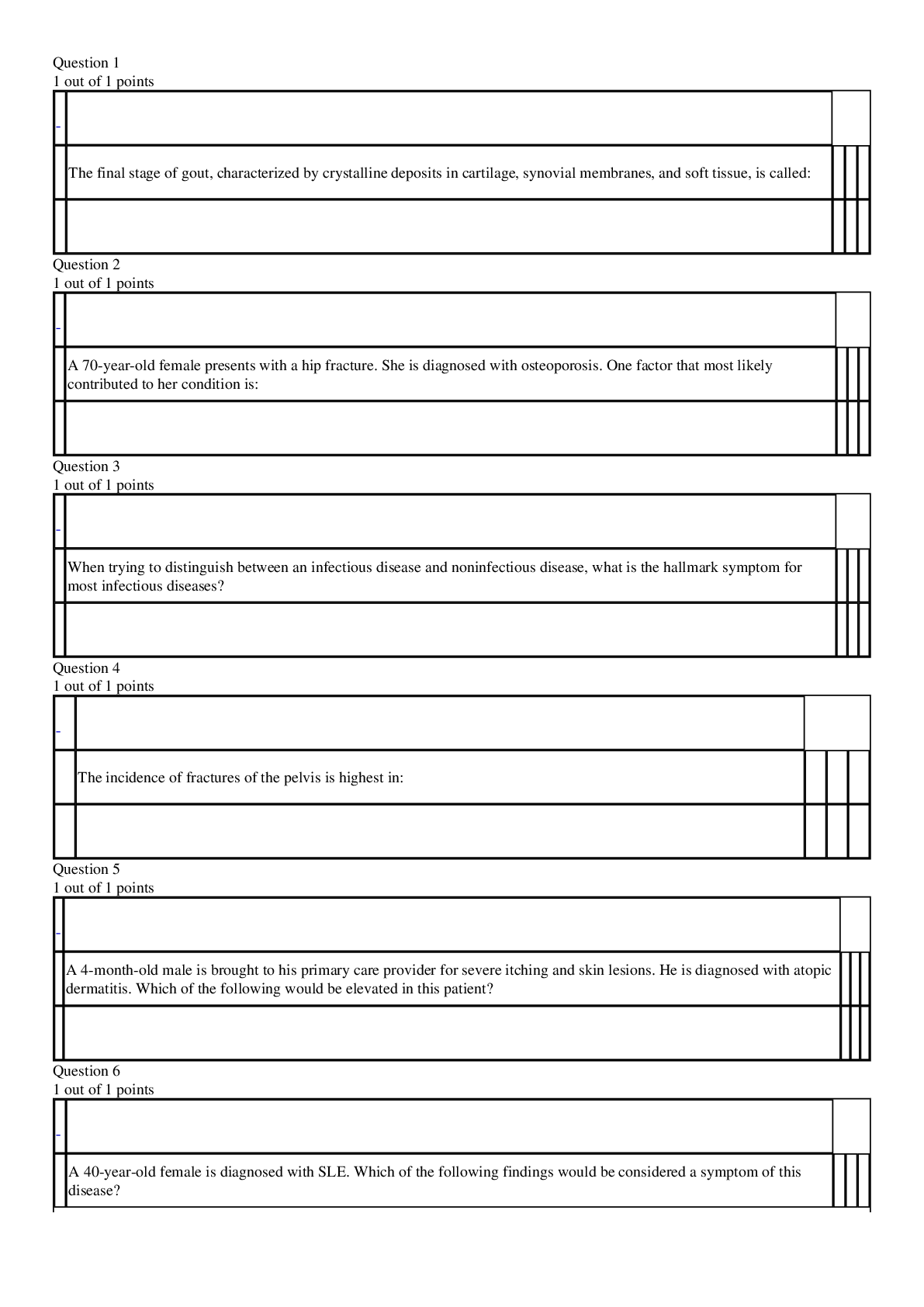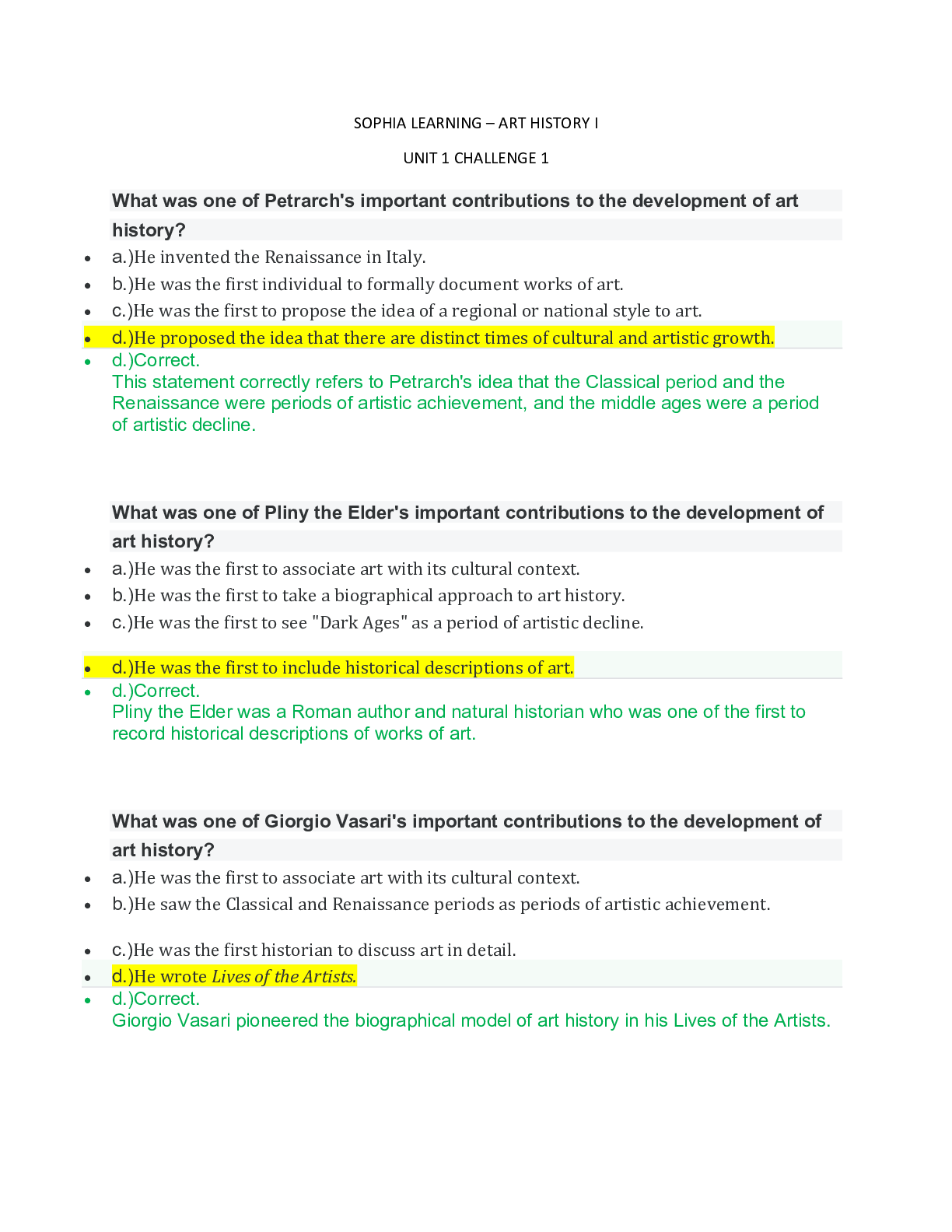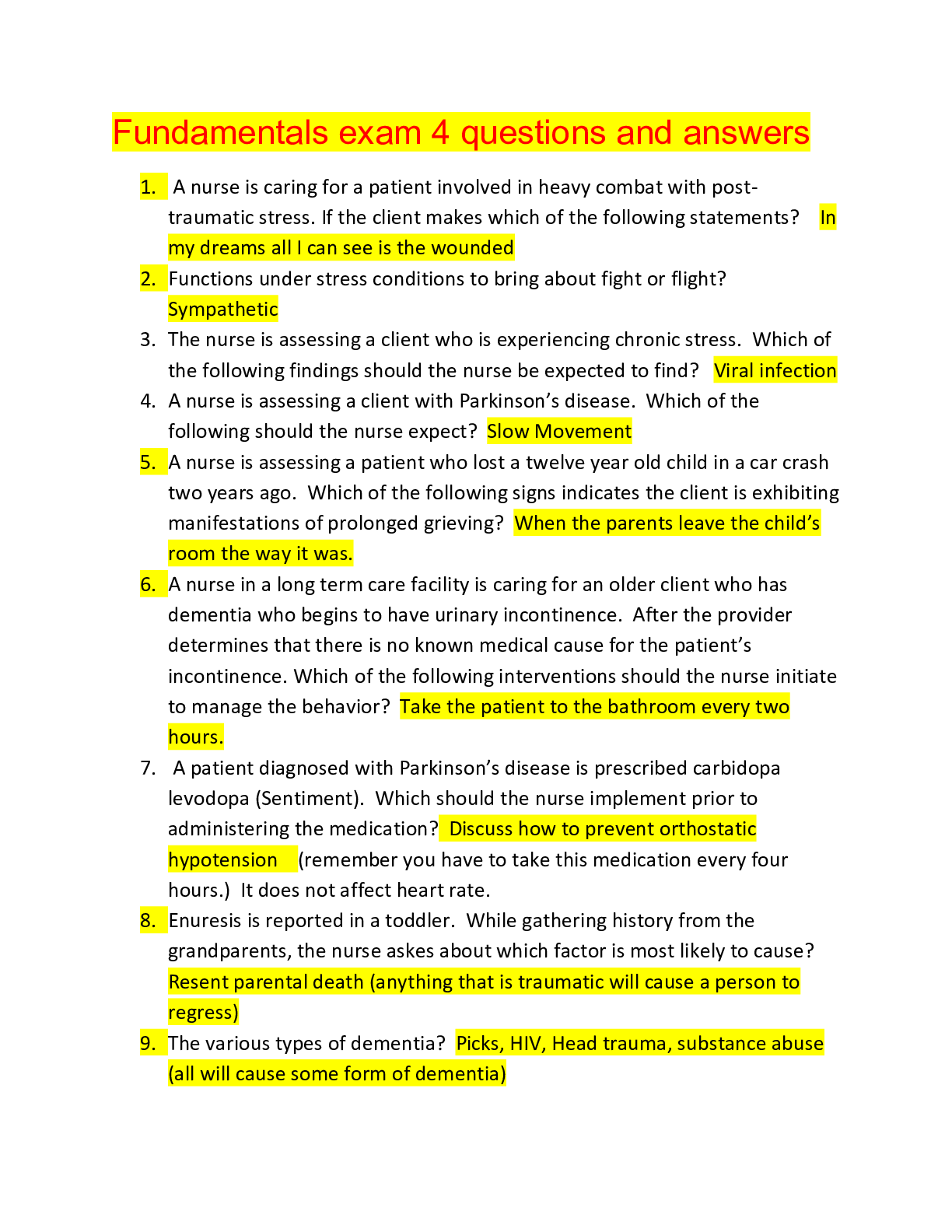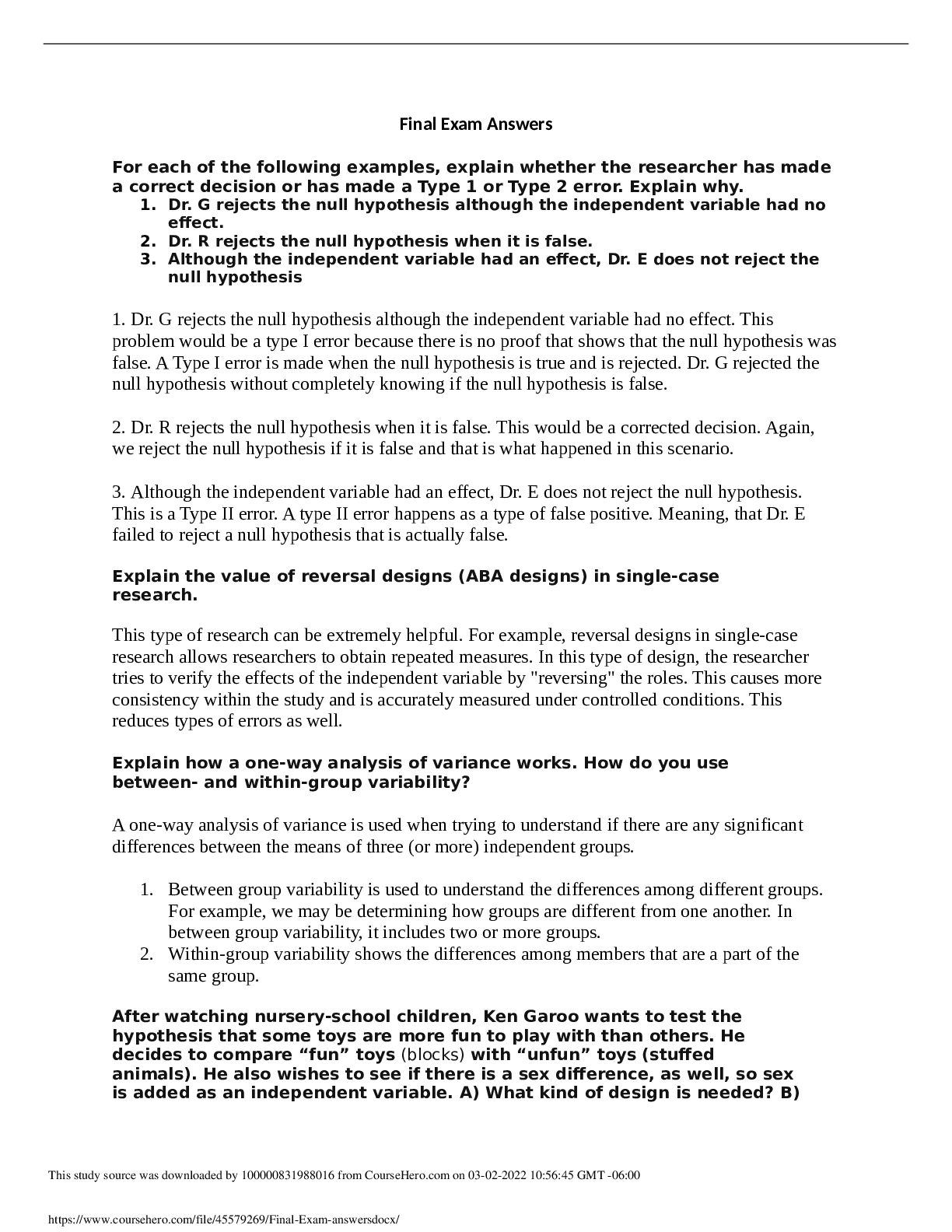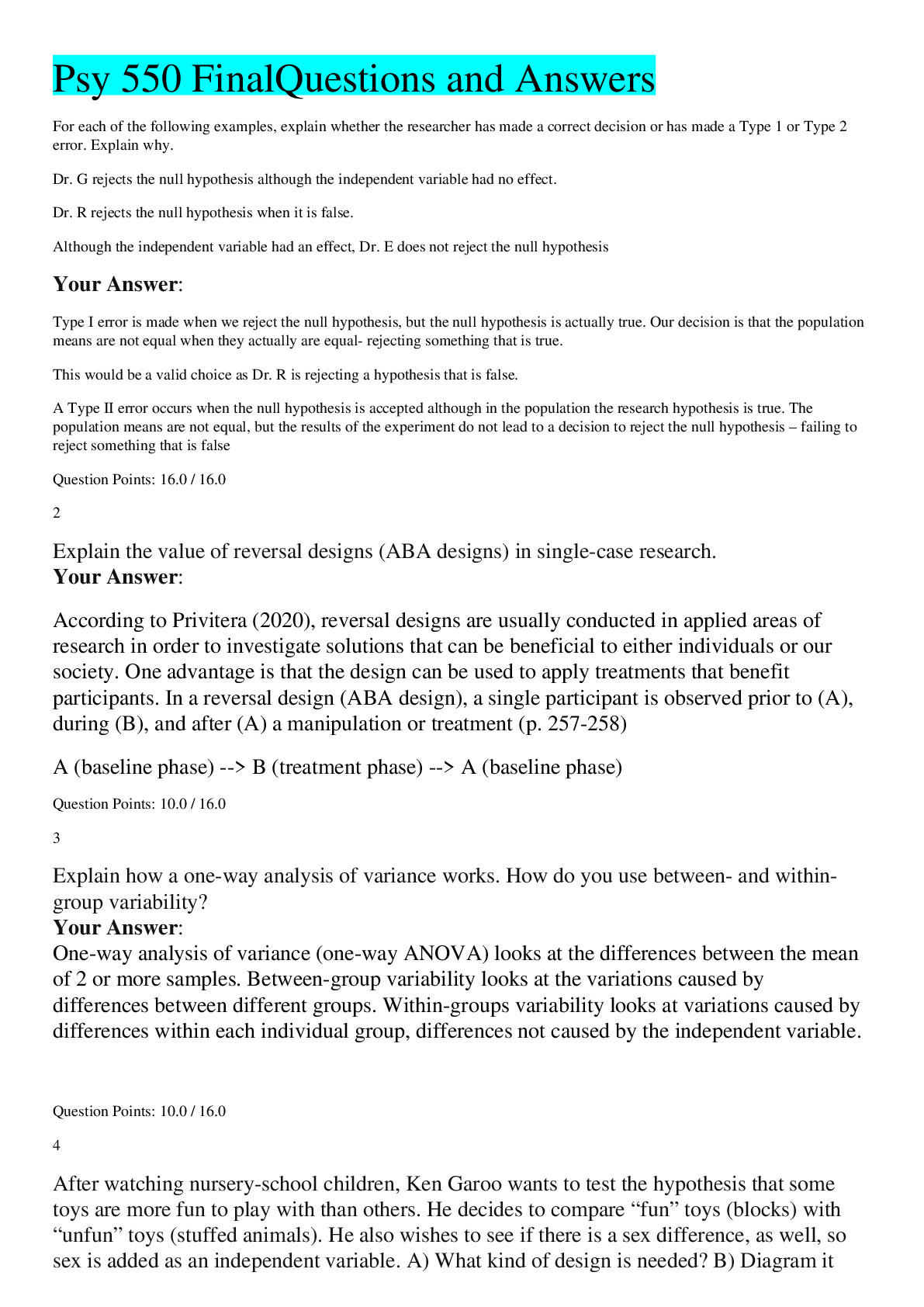English Language > EXAM > LETRS Glossary Volume 1 Units 1-4 Quiz Questions and Answers,100% CORRECT (All)
LETRS Glossary Volume 1 Units 1-4 Quiz Questions and Answers,100% CORRECT
Document Content and Description Below
LETRS Glossary Volume 1 Units 1-4 Quiz Questions and Answers academic language - Correct Answerwritten or spoken language that is more stylistically formal than spoken conversational language; lang... uage that is most often used in academic discourse or text. adjective - Correct AnswerA part of speech that describes a noun or person (e.g., windy, blue). adverb - Correct AnswerA part of speech that describes a verd, adjective, or adverb (e.g., sadly, crookedly). affricate - Correct AnswerA speech sound with features of both a fricative and a stop; in English, /ch/ and /j/ are ________. allophones - Correct AnswerSlight alterations to pronunciation of phonemes resulting from phonemes overlapping with one another in a spoken word; these variations of pronunciation are predictable and unconscious, as most speakers make them. allophonic variation - Correct AnswerThe slightly different pronunciation of a phoneme, depending on its place in a word; for example, automatic nasalizing of a vowel before a nasal consonant. alphabetic principle - Correct AnswerThe concept that letters are used to represent individual phonemes in the spoken word; insight into this principle is critical for learning to read and spell. antonym - Correct AnswerA word that overlaps with another word, but which has the opposite meaning. automaticity - Correct AnswerThe ability to read quickly and accurately without conscious effort. background knowledge - Correct AnswerPreexisting knowledge of facts and ideas necessary to make inferences. base words - Correct AnswerWords that can stand on their own, or can serve as part of another word, as a free morpheme. benchmark - Correct AnswerA standard or a set of standards used as a threshold for predicting future risk for reading difficulty. blend - Correct AnswerTwo or three graphemes, each one representing a phoneme (e.g., the s-c-r in scrape); a ________ is not one sound, but two or three adjacent consonants before or after a vowel in a syllable. characters - Correct AnswerThe protagonist or who the story is about, plus optional secondary people or animals whose roles within the story help the plot to unfold. clause - Correct AnswerA group of words that has a subject and a predicate and functions as a unit. closed syllable - Correct AnswerA syllable with a short vowel spelled with a single vowel letter and ending in one or more consonants (e.g., hat, kit-ten). coarticulation - Correct AnswerOccurs when phonemes are spoken together to produce syllables or words and the features of these phonemes are affected by the speech sounds that precede or follow them. code switching - Correct AnswerThe conscious effort to write and/or speak in a certain way, depending on the social context and/or whether the language is spoken or writter. cognate - Correct AnswerA word in one language that shares a common ancestor and common meanings with a word in another language. Many Spanish words, such as "problema" or "diagrama," are ________ that are built around the same Latin and Greek prefixes, suffixes, or roots that English words also employ. coherence - Correct AnswerThe property of sticking together into a consistent whole; can refer to a quality of text or to the representation of meaning in a person's mind. cohesive devices - Correct AnswerThe specific linguistic devices by which a text hangs together, such as pronoun references, repeated phrases, or substitution or one phrase for another. comparative adjective - Correct AnswerAn adjective that compares two nouns or pronouns (e.g., Sarah is taller than Monique; the red flower is more colorful than the pink one). complementary antonym - Correct AnswerAn antonym that is mutually exclusive from its opposite term. complex sentence - Correct AnswerA complex sentence has an independent clause and a dependent clause; the dependent clause only makes sense with the independent clause in the sentence (e.g., "When she came into the room, the class settled down."). composition - Correct AnswerThe skill of formulating ideas into words, incorporating subskills such as knowledge of the topic, vocabulary, and Standard English grammar and usage. compound sentence - Correct AnswerA sentence with two independent clauses that are joined by a coordinating conjunction (e.g., "The cat crouched to pounce and her tail twitched."). conditional verb forms - Correct AnswerA challenging sentence feature that expresses a situation that is hypothetical or highly unlikely (e.g. "If the apples were ripe, he might have made a tart."). conjunctions - Correct AnswerThe parts of speech that connect the words, phrases, or clauses and indicate the relationship between the elements joined. conjunctive (connecting) adverbs - Correct AnswerConjunctions that connect two independent clauses in one sentence or link ideas in two or more sentences. They often show cause and effect, sequence, or compare and contrast relationships. consonant - Correct AnswerA phoneme (speech sound) that is not a vowel and that is formed by obstructing the flow or air with the teeth, lips, or tongue; English has 25 ________ phonemes. consonant blend - Correct AnswerTwo or three consonant phonemes before or after a vowel in a syllable (e.g., bl-, fr-, str-, -nd, -sp). consonant-le (Cle) syllable - Correct AnswerAn unaccented final syllable containing a consonant before / followed by silent e (e.g., ea - gle, drib - ble). coordinating conjunctions - Correct AnswerConjunctions that connect grammatically equal parts of sentences, such as words to words, phrases to phrases, and clauses to clauses. curriculum-based measurements (CBMs) - Correct AnswerStandardized measurements that assess content that students should master by the end of the grade level that the measurement represents; requires standard administration and scoring. decoding - Correct AnswerThe ability to translate a word from print to speech, usually by employing knowledge of sound-symbol correspondences. dependent clause - Correct AnswerA clause that begins with a subordinating conjunction or a realtive pronoun and expresses an incomplete thought; it can't stand on it's own (e.g., "after we went home" or "when the sun sets"). derivational suffixes - Correct AnswerGrammtical endings that mark or determine the part of speech of the suffixed word. diagnostic decoding survey - Correct AnswerA diagnostic tool that is used as a screening test to measure decoding with a large group of students, or for in-depth diagnosis with individual students; also known as a diagnostic phonics survey. dialect - Correct AnswerAn intelligible version of a language with systematic differences in phonology, word use, and/or grammatical skills. digraph - Correct AnswerA two-letter combination (e.g., th, ph) that stands for a single phoneme in which neither letter represents its usual sound. dipthongs - Correct AnswerSingle vowel phonemes that glide in the middle; the mouth position shifts during the production of the single vowel phoneme, especially the vowels spelled ou and oi. discourse - Correct AnswerWritten or spoken communication or the exchange of information and ideas, usually longer than a sentence, between individuals or between the writer and the reader. discourse comprehension - Correct AnswerThe understanding of meanings in longer segments of connected text, whether written or spoken. double deficit - Correct AnswerA combination of phonological and naming-speed dificits. double negative - Correct AnswerA challenging sentence that contains two negative elements (e.g., "I never told her not to eat the sandwiches."). doublet - Correct AnswerA double letter (e.g., ff, ll, ss, zz) that represents one phoneme (e.g., the zz in buzz). dysgraphia - Correct AnswerA breakdown in the communication pathways between the mind's image of a letter and the hand's ability to produce that letter in written form. elaborative questioning - Correct AnswerQuestioning that requires students to integrate information from the text with prior knowledge, mental images, feelings, or bigger ideas relevant to the text. ellipses - Correct AnswerA cohesive device that occurs when words that name or refer to an entity already named are assumed but not stated. expressive vocabulary - Correct AnswerThe words one uses in speaking and writing. functional writing skills - Correct AnswerThe skills necessary to transcribe or encode words into written symbols, using phonological, orthographic, morphological, and syntactic aspects of language. fricative - Correct AnswerA consonant sound created by forcing air through a narrow opening in the vocal tract; includes /f/, /v/, /s/, /z/, /sh/, /zh/, and /th/. genre - Correct AnswerA distinct type of literature, characterized by convention of structure and content. glide - Correct AnswerA type of speech sound that glides immediately into a vowel; includes /h/, /w/, and /y/. gradable antonym - Correct AnswerAn antonym that takes its meaning from the context in which it is used, and is therefore subject to scaling. grapheme - Correct AnswerA letter or letter combination that spells a phoneme; can be one, two, three, or four letters in English (e.g., e, ei, igh, eigh). graphic organizer - Correct AnswerA visual representation of the logical relationships among ideas. graphomotor skill - Correct AnswerThe skill of manually forming the letters that represent written language. high-frequency words - Correct AnswerWords that occur most often in written English, including articles, common nouns, pronouns, conjunctions, and auxiliary (helping) verbs. independent clause - Correct AnswerA clause that expresses a complete thought and can stand on its own. inferences - Correct AnswerAssumptions that a reader makes based on evidence from the text and the reader's own experiences. inflectional suffixes - Correct AnswerGrammatical endings that do not change the part of speech of the word to which they are added. interjection - Correct AnswerA word used to express emotion (e.g., Yikes! Wow!). lexical quality - Correct AnswerThe nature of a stored word image in the brain. A high quality representation of a word in memory enable orthographic mapping better than a partial or poorly elaborated word image. lexicon - Correct AnswerThe name for the mental dictionary in every person's phonological processing system. liquid - Correct AnswerThe speech sounds /l/ and /r/ that have vowel-like qualities and no easily definable point of articulation. low-frequency words - Correct AnswerWords that do not occur often in printed text, and which are likely to be found only in text concerning a specific topic. macroprocesses - Correct AnswerThought processes and/or activities by which students process and transform new information so that it is "owned." mental model - Correct AnswerThe mental representation of a text's meaning that locates those meanings within a wide context of time, place, and circumstance. Also known as situation model. metacognition - Correct AnswerThe act of monitoring and assessing one's own awareness and thought processes. metalinguistic awareness - Correct AnswerThe ability to think about and reflect on the structure of language itself. The invention of the alphabet was an achievement in ________ ________. morpheme - Correct AnswerThe smallest meaningful unit of language; it may be a word or a part of a word; it may be a single sound (e.g., plural /s/), one syllable (e.g., suffix -ful), or multiple syllables (e.g., prefix inter-). morphology - Correct AnswerThe study of meaningful units in language and how the units are combined in word formation. morphonemic - Correct AnswerEnglish orthography is ________, which means that it is a deep alphabetic writing system organized by both sound-symbol correspondences and morphology. nasal - Correct AnswerA type of phoneme that directs resonance through the nose; in English, /n/, /m/, and /ng/ are ________ phonemes. nonstandard dialect - Correct AnswerAny dialect that differs from Standard American English (SAE), which refers to English that is generally used in professional communication and taught in American schools. norm-referenced tests - Correct AnswerStandardized tests that are designed to compare and rank test-takers in relation to each other. noun - Correct AnswerA part of speech that names a person, place, thing, or idea (e.g., potatoes, anger). noun phrase - Correct AnswerA phrase that includes a noun and the words that modify it (adjectives), such as "the cold glass" or "a fragrant rose." onset-rime - Correct AnswerThe natural division of a syllable into two parts; the onset comes before the vowel, and the rime includes the vowel and what follows after it (e.g., pl - an). open syllable - Correct AnswerA syllable ending with a long vowel sound that is spelled with a single vowel letter (e.g., me, yo-yo). orthographic mapping - Correct AnswerThe mental process used to store words for immediate and effortless retrieval. It requires phonemic awareness, letter-sound knowledge, and the mechanism for sight word learning. orthography - Correct AnswerA writing system for representing language. paragraph - Correct AnswerA number of sentences about the same topic or idea that are grouped together and formatted in a certain way. passive voice - Correct AnswerA challenging sentence feature wherein the subject receives the action (e.g., "Someone had cleaned the windows."). phoneme - Correct AnswerA speech sound that combines with others in a language system to make words; English has 40 to 44 ________s, according to various linguists. phoneme-grapheme mapping - Correct AnswerThe matching of phonemes (sounds) in words with the graphemes (letters) that represent them. phonemic awareness - Correct AnswerThe conscious awareness of the individual speech sounds (consonants and vowels) in spoken syllables and the ability to consciously manipulate those sounds. phonetics - Correct AnswerThe study of the sounds of human speech; articulatory ________ refers to the way the sounds are physically produced in the human vocal tract. phonics - Correct AnswerThe study of the relationships between the letters and the sounds they represent; also used as a descriptor for code-based instruction. phonological awareness - Correct AnswerThe conscious awareness of all levels of the speech sound system, including word boundaries, stress patterns, syllables, onset-rime units, and phonemes. phonological lexicon - Correct AnswerThe brain's storehouse of words previously heard, but not necessarily understood. phonological processing - Correct AnswerMultiple functions of speech and language perception and production, such as perceiving, interpreting, storing (remembering), recalling or retrieving, and generating the speech sound system of a language. phonological working memory (PWM) - Correct AnswerThe "online" memory system that remembers speech long enough to extract meaning from it, or that holds onto words during writing; a function of the phonological processing system. phonology - Correct AnswerThe rule system within a language by which phonemes can be sequenced, combined, and pronounced to make words. phrases - Correct AnswerGroups of words that cluster together to fill grammatical slots in sentences. plot - Correct AnswerThe events in a narrative text, or story, that include a problem that the main character is trying to solve, attempt(s) to solve it, and a resolution. pragmatics - Correct AnswerThe system of rules and conventions for using language and related gestures in a social context. preposition - Correct AnswerA part of speech that is placed before a noun or pronoun to form a phrase modifying another word in the sentence (e.g., under, around). prepositional phrase - Correct AnswerA phrase introduced by a preposition and which includes a noun phrase (e.g., "against the tide" or "upon my nose"). pronoun - Correct AnswerA part of speech that is used in place of a noun (e.g., I, we, ours, yours). pronoun reference - Correct AnswerA word, usually a pronoun, used to refer to something else that has alread been named in a text. prosody - Correct AnswerThe rhythms and patterns of sounds in spoken language; expression. qualitative spelling screener - Correct AnswerA list of words with a variety of orthographic patterns, specifically designed to assess students' spelling levels and knowledge of those patterns. rapid automatic naming (RAN) - Correct AnswerThe ability to quickly name a series of printed, repeated numbers, letters, or objects that should be known by rote. receptive vocabulary - Correct AnswerThe words whose meanings one can recongize when reading or listening to others speak. reliable measure - Correct AnswerA measure that is likely to yield the same result if it were to be given several times on the same day in the same context. root - Correct AnswerA bound morpheme, usually of Latin origin, that cannot stand alone but that is used to form a family of words with related meanings (e.g., spect, vis). scaling - Correct AnswerThe expression of words on a continuum to show degrees of meaning. schema - Correct AnswerA mental model or conceptual framework for a specific topic or idea. schwa - Correct AnswerThe empty vowel in an unaccented syllable, such as the last syllable in wagon or rebus. semantic lexicon - Correct AnswerThe brain's "mental dictionary" or word meanings, including synonyms and related mental concepts. semantic map - Correct AnswerThe association of meanings and context for a given word, including structure, origin, images, and personal associations, synonyms, antonyms, and historical or cultural connotations. semantic overlap - Correct AnswerCommon features between words that are not synonyms. semantic properties - Correct AnswerThe features or attributes of a morpheme, word, or sentence that contribute to its meaning. semantics - Correct AnswerThe study of word and phrase meanings and relationships. setting - Correct AnswerWhere and when a narrative text, or story, occurs. sight vocabulary - Correct AnswerA student's bank of words that are instantly and effortlessly recognized; includes both regularly spelled and irregularly spelled words. silent letter combination - Correct AnswerA letter combination where one or more letters is silent (i.e., does not represent the phoneme) but another letter does represent the phoneme (e.g., kn in knock). simple sentence - Correct AnswerAn independent clause with a subject and a predicate. single deficit - Correct AnswerA prominent and specific weakness in either phonological processing or rapid print (naming-speed) processing. socioeconomic status (SES) - Correct AnswerRefers to a combination of the education, income, and occupation of an individual or a social group. stop - Correct AnswerA type of consonant that is spoken with one push of breath and not continued or carried out, including /p/, /b/, /t/, /d/, /k/, and /g/. story grammar - Correct AnswerA set of conventions used in a narrative, including setting, characters, a problem to be solved, climax, and conclusion. subjunctive mood - Correct AnswerA challenging sentence feature that expresses a mood for something wished for or imagined (e.g., "What might have happened if the plane had landed on time?"). subordinating conjunctions - Correct AnswerConjunctions that connect clauses that are not equal. substitution - Correct AnswerA cohesive device that renames a person, place, thing, idea, or action with a word or phrase that means the same thing but that is not a pronoun. superlative adjective - Correct AnswerAn adjective that compares three or more nouns or pronouns (e.g., Sarah is the tallest student; the red flowers are the most colorful in the garden). surface code - Correct AnswerRefers to literal word and phrase meanings in a sentence. syllable - Correct AnswerThe unti of pronunciation that is organized around a vowel; it may or may not have a consonant after the vowel. synonym - Correct AnswerA word that overlaps extensively in meaning with another word. syntax - Correct AnswerThe system of rules governing permissible word order in sentences. text base - Correct AnswerThe underlying meanings to which words in text refer. text-dependent questions - Correct AnswerQuestions that require students to refer back to the text and develop answers based on inferences made from the text. topic sentence - Correct AnswerA sentence that usually begins the paragraph and states the main idea trigraph - Correct AnswerA three-letter combination that represents one phoneme (e.g., -tch in ditch and -dge as in dodge). valid measure - Correct AnswerA measure that measures what was intended (construct validity); corresponds well to other known, valid measures (concurrent validity); and predicts with good accuracy how students are likely to perform on an accountability measure (predictive validity). verb - Correct AnswerA part of speech that expresses an action or state of being (e.g., running, thinks). verb phrase - Correct AnswerA phrase that includes a verb and its modifiers (adverbs), such as "is eating quickly" or "jumped lightly." vocabulary - Correct AnswerKnowledge of, and memory for, word meanings. vowel - Correct AnswerOne of a set of 15 vowel phonemes in English, not including r-controlled combinations in a schwa; an open phoneme that is the heart of every spoken syllable; classified by tongue position and height (e.g., high to low, and front to back). vowel team - Correct AnswerA combination of two, three, or four letters that stand for a vowel (e.g., au, ea, oo, eigh). vowel team syllable - Correct AnswerA syllable with a long or short vowel spelling that uses 2-4 letters to spell the vowel sound (e.g., toy, light, four - teen); includes dipthongs ou/ow and oi/oy. vowel-consonant-e (VCe) - Correct AnswerA common pattern for spelling a long vowel sound (e.g., rate, ice). vowel-consonant-e (VCe) syllable - Correct AnswerA syllable with a long vowel spelled with one vowel plus one consonant plus silent e (e.g., note, fire - place). vowel-r combination - Correct AnswerA single vowel letter followed by r (ar, er, ir, or, ur) that stands for a unique vowel sound. vowel-r syllable - Correct AnswerA syllable with er, ir, or, ar, or ur (e.g., for, start); the vowel sound before the letter r ofter changes its pronunciation. [Show More]
Last updated: 1 year ago
Preview 1 out of 14 pages
Instant download
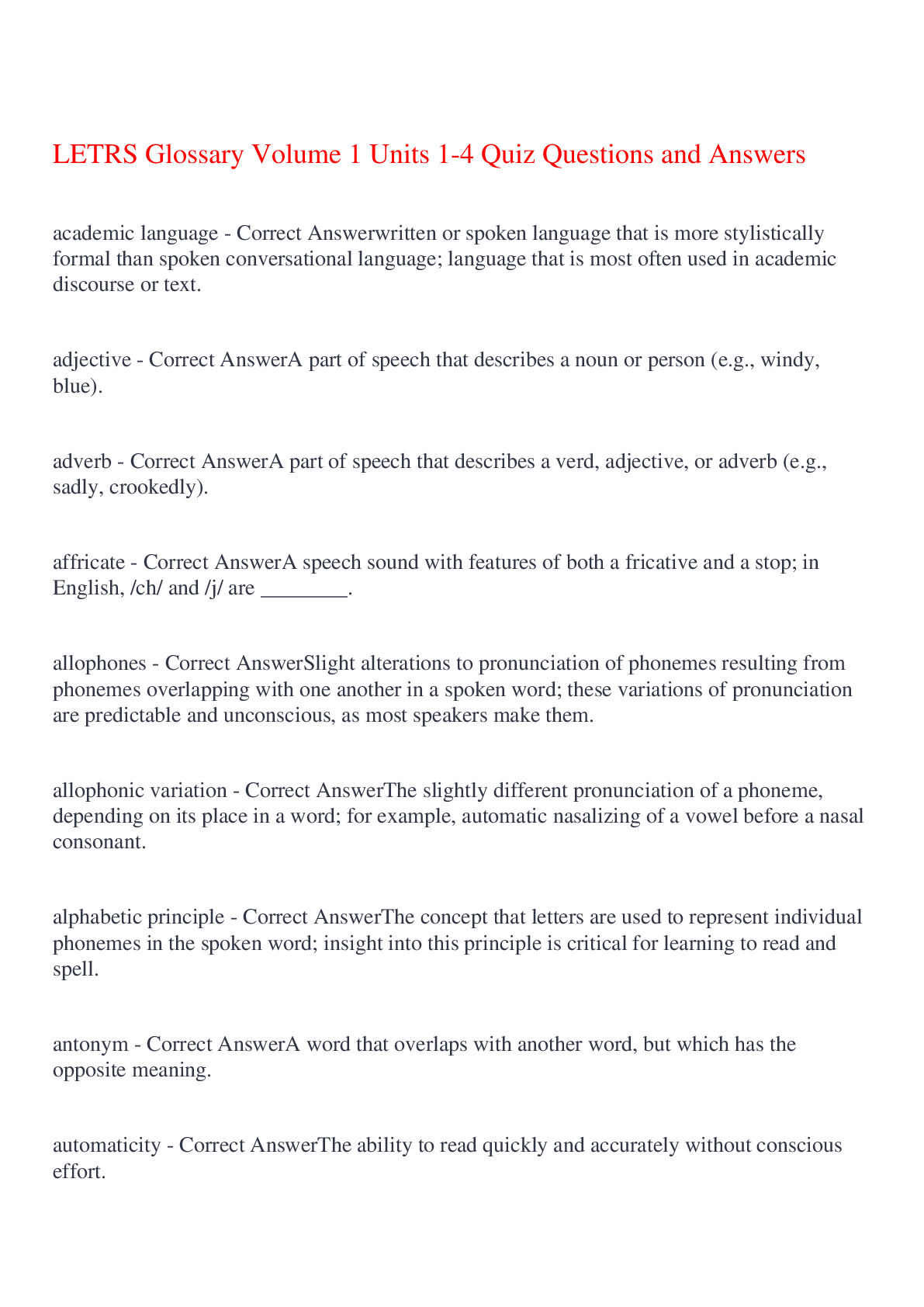
Buy this document to get the full access instantly
Instant Download Access after purchase
Add to cartInstant download
Reviews( 0 )
Document information
Connected school, study & course
About the document
Uploaded On
Feb 12, 2023
Number of pages
14
Written in
Additional information
This document has been written for:
Uploaded
Feb 12, 2023
Downloads
0
Views
34













